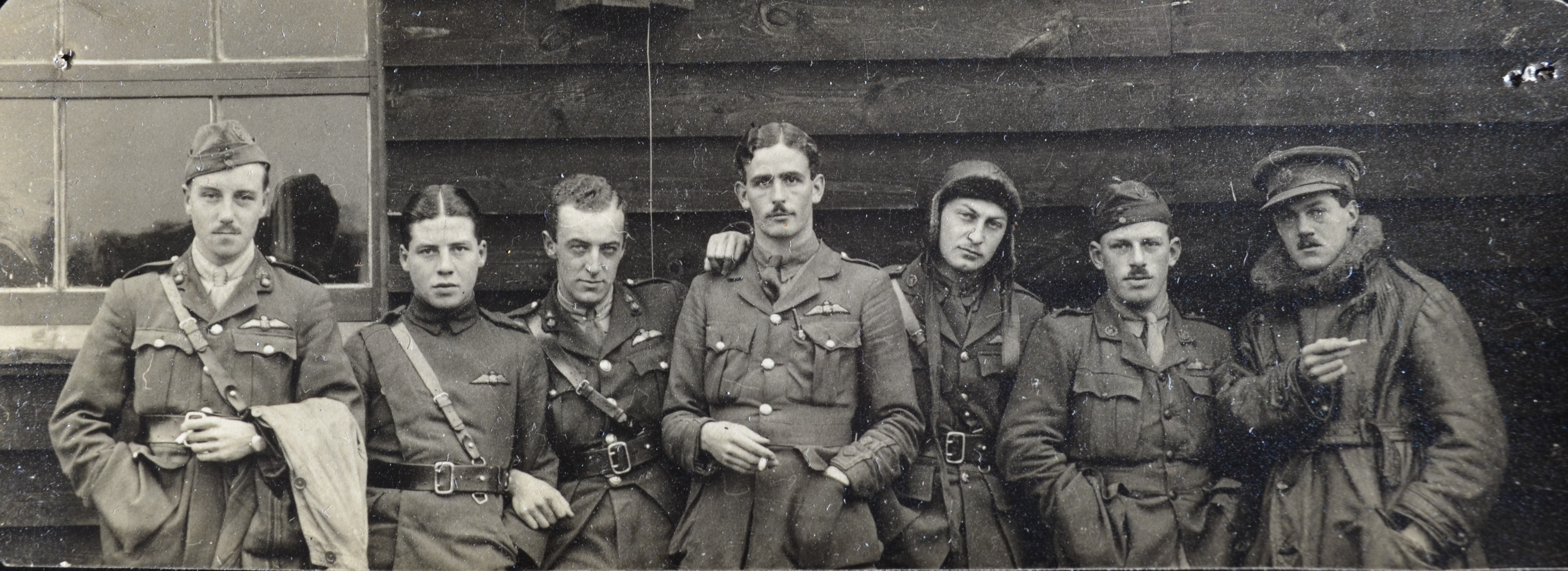Edward Pellew Plenty
Major Edward Pellew Plenty, Royal Air Force
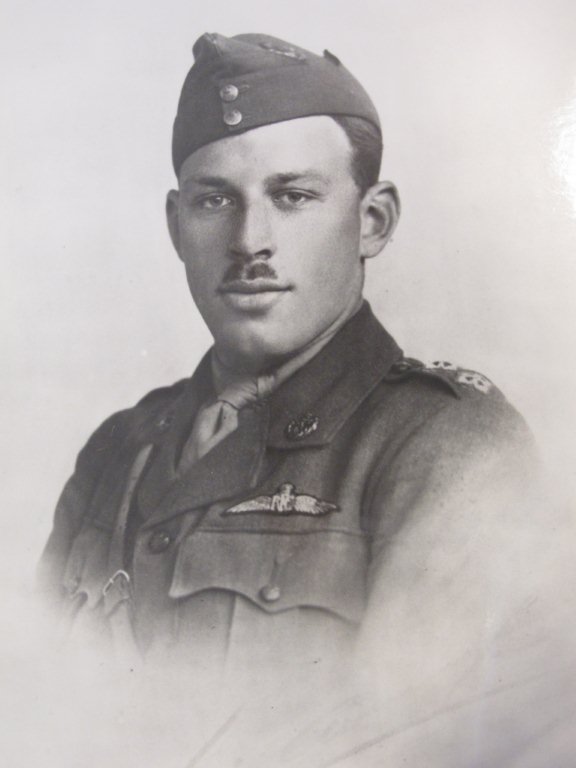
Edward Pellew Plenty IV |
Edward was born in Newbury on 6 July 1897, the only son of Edward Pellew (Jack) Plenty III and his wife Jessie née Hamlen. He was the second of his parent’s three children, his siblings being Kathleen (born 1894) and Barbara (1906).
The unusual middle name came from Admiral Edward Pellew, 1st Viscount Exmouth, who was a friend and supporter of Jack’s great-grandfather, William Plenty. Pellew made his name as a frigate captain being knighted for his success in capturing a French frigate in 1793, the first such success of the war with revolutionary France. However, he is probably best known from the novels of C S Forester as the captain who nurtured the early career of Horatio Hornblower.
Pellew met William Plenty following William’s success in winning a competition to design a practical lifeboat for the predecessor of the Royal National Lifeboat Institution. At the time when there were only 14 lifeboats stationed around the coast, 11 of them had been built in Newbury! The Admiral was godfather to the first Edward Pellew Plenty (Jack’s grandfather) and the name became a fixture in the family. Jack’s father Edward Pellew Plenty II absconded to Portugal with much of the company’s cash and Jack took over the running of Plenty & Son, a major Newbury company and employer, in his early twenties. His son was destined to take the reins when Jack retired.
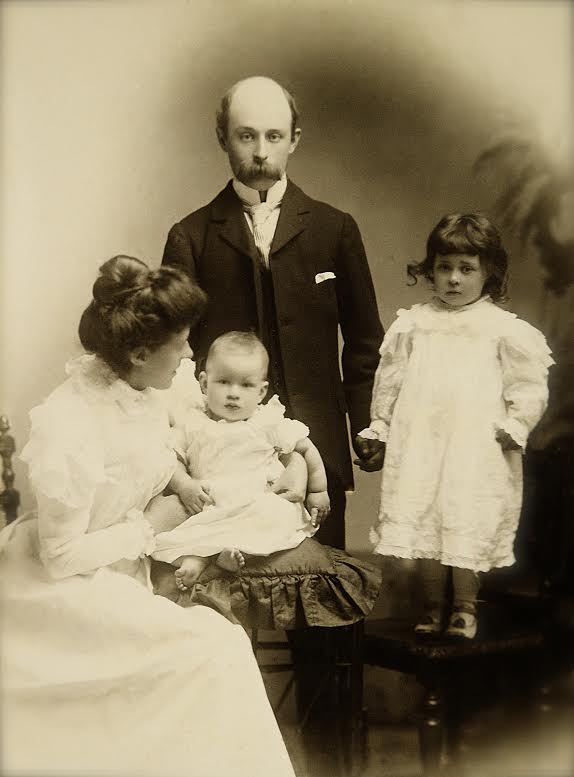
Edward's parents and sisters. |
Young Edward was educated at Newbury Grammar School (1907-1910) and St Paul’s School (1910-1914). On 15 September 1914, at the age of 17, he enlisted into the Army, lying about his age and claiming to be aged 18 years 6 months. He joined the Royal Fusiliers (Public Schools Battalion) as a Private, number 2369. At this age he was already describing his occupation as ‘engineer’.
The Army monitored the Public Schools Battalion closely in the hunt for prospective officers, many of its recruits were just what they were looking for. Edward’s abilities were spotted very quickly and on 22 November 1914 he arrived at Sandhurst for officer training. On completion of the course he was commissioned as a 2nd Lieutenant in the Manchester Regiment.
By this time, he had become attracted to the idea of flying, so he did not serve as an infantry officer instead moving on to flying school at Farnborough. He was awarded his flying certificate on 2 June 1915 after a test flight in a Maurice Farman biplane (a very different beast to the combat aircraft he would fly in France). His training continued with 15 Squadron at Dover as he learnt to fly different aircraft and to develop his flying skill. His commanding officer recommended that he was appointed a Flying Officer in the RFC with effect from 30 August 1915, at the same time asking that Edward remain with 15 Squadron as an instructor if he was not immediately needed in France. He also remarked that Edward had ‘the makings of a really good pilot’.
Evidently there was immediate need since he went to France on 9 September 1915. His RFC promotion was reflected in his promotion to the substantive rank of Lieutenant with a seniority date of 1 October 1915 – he was still considered an officer of the Manchester Regiment – attached to the Royal Flying Corps. He flew with No 1 Squadron, RFC until April 1916. The squadron’s main role was reconnaissance; it operated a variety of aircraft at this time: Avro 504s, B.E.8s, Morane Parasols and a few single seat fighters for escort purposes. In 1917 it converted to a fighter squadron, but Edward had moved on by then.
In April 1916 he was promoted within the RFC from Lieutenant/Flying Officer to Captain – this was a temporary rank; he would revert to Lieutenant should he leave the Corps. The new rank meant that he would be a Flight Commander – still aged only eighteen. He was posted back to England to help prepare a new squadron for duty in France, returning with it to the front in October 1916. The new unit was 46 Squadron which was raised at Wyton, Huntingdonshire on 19 April 1916 and proceeded to France in October where it was based at La Gorgue and was employed in artillery spotting and reconnaissance flying Nieuport two-seaters.
Edward must have excelled himself almost immediately – General Haig’s dispatch dated 30 April included his name among a long list of men he wished to ‘bring to notice for gallant and distinguished conduct in the field’. This would have resulted in Edward received the oak leaf emblem for ‘Mentioned in Dispatches’ which could be worn on the ribbon of an appropriate campaign medal.
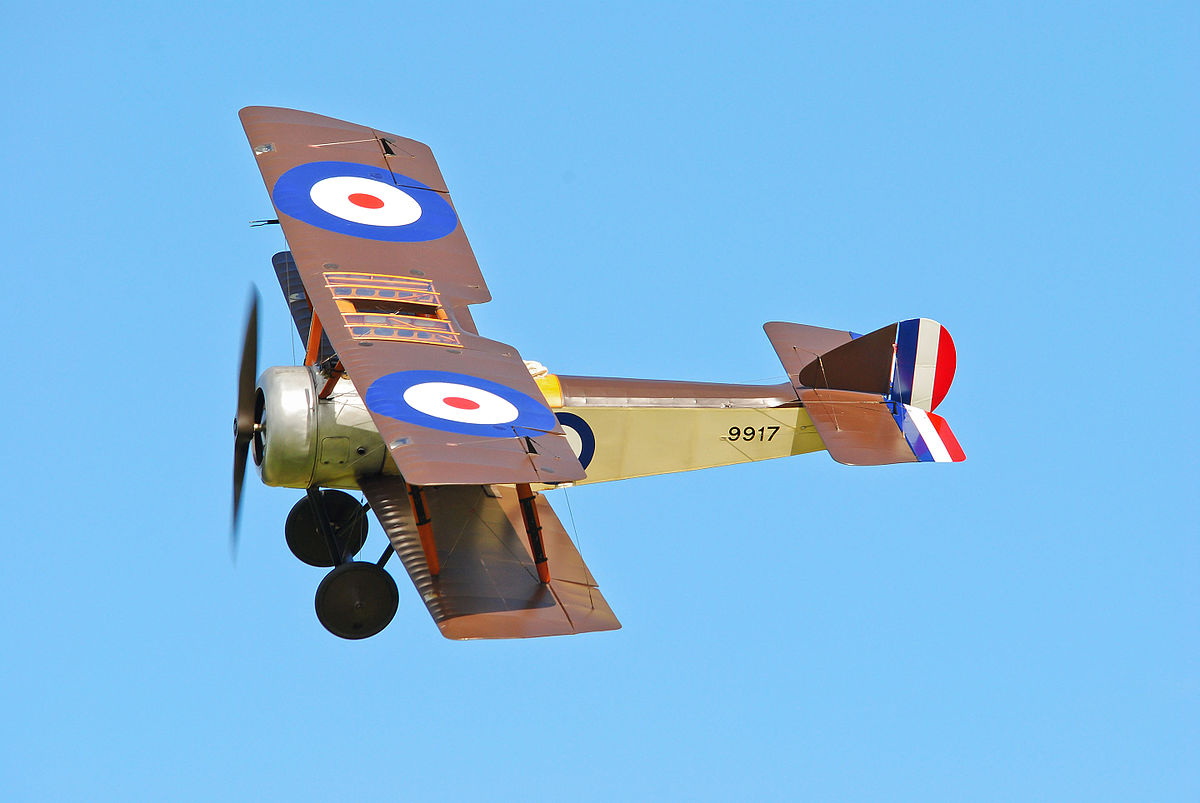
Sopwith Pup - a superior aircrft to the Fokker Triplanes flown by Baron von Richthofen in early 1917, but it was soon surpassed by new German designs. |
In June 1917 Edward returned to England again. His obituary (below) suggests that this was because he had ‘served his time in France’, which suggests that he was being rested after a tour of duty. But Edward’s service record shows a less complementary reason – he had contracted syphilis and was sent to England for treatment. On 12 September 1917 a medical board approved his return to work on desk duty for a month, light duties for another month and declared that he was not to be cleared for active service until he had proven his fitness by flying at high altitude for a month. Another board on 23 November cleared him to start the month’s high flying.
This would not be aimless flights simply to prove his fitness, he was sent to a flying school in Norfolk, where his experience and skills could be passed on to new pilots. On 1 April 1918, while Edward was still in Norfolk the RFC was amalgamated with much of the Royal Naval Air Service to create the Royal Air Force. From Norfolk he moved to York as brigade examining officer to the Northern Training Brigade – a move that included his promotion to Major on 6 April 1918.
Newbury Weekly News, 30 May 1918 – Local War Notes
Captain Edward Plenty, RAF, son of Mr and Mrs E P Plenty, of Newbury, has been promoted to the rank of Major.
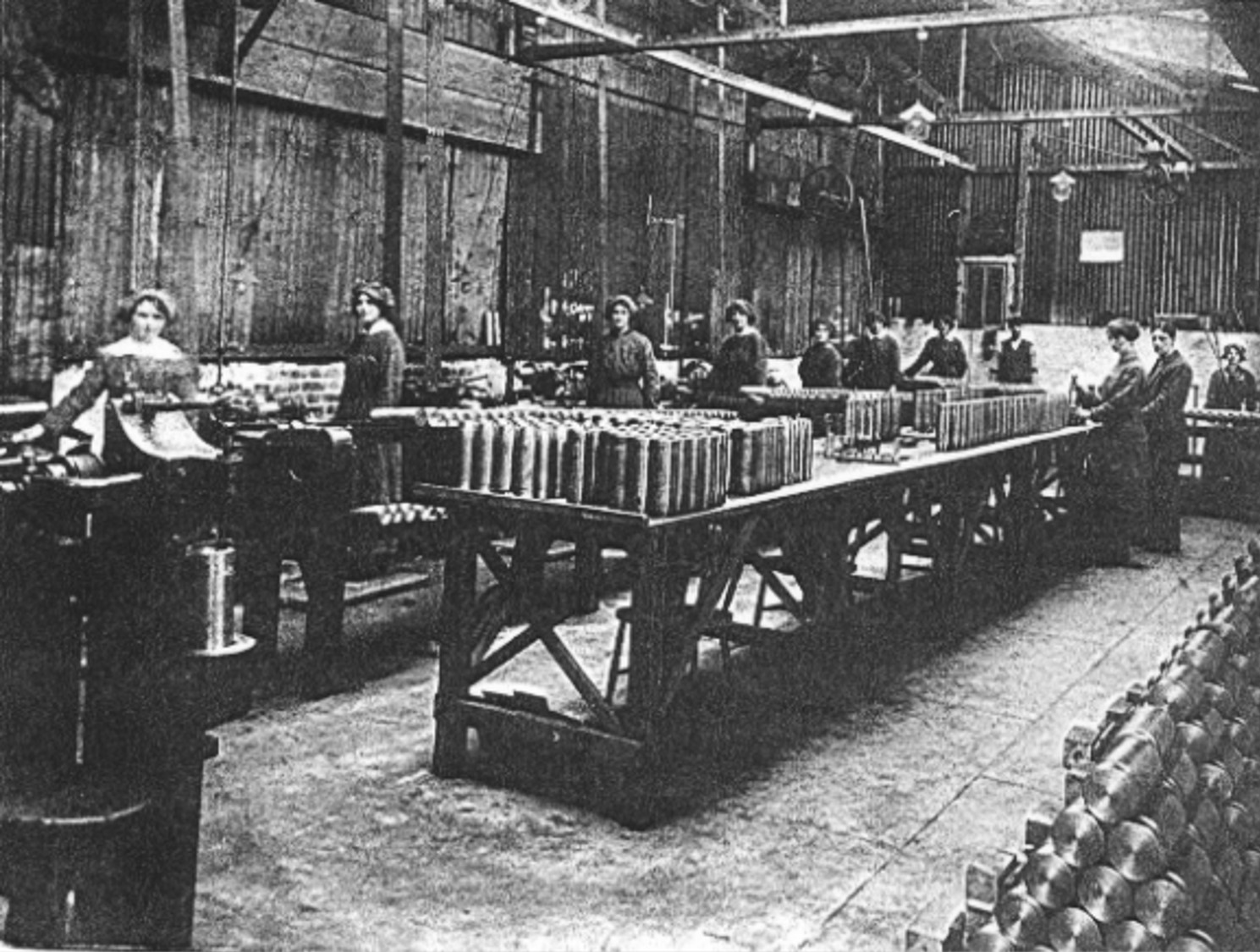
During the war Plenty's manufactured shells for the army usng a many female workers. |
On 27 September 1918 he returned to Wyton to take command of 96 Squadron and prepare it for deployment to the front. The Armistice brought the war to an end on 11 November, before 96 Squadron went overseas. A week after the Armistice Edward was admitted into a VAD (Voluntary Aid Detachment) hospital in Huntingdon suffering from influenza – 3 days later, on 21 November 1918, he died there, another victim of the infamous ‘Spanish Flu’ that killed over 20 million people worldwide. He was still only 21 years old.
Newbury Weekly News, 29 November 1918 – Edward Pellew Plenty
DEATH OF AN OFFICER - PROMISING CAREER CUT SHORT
Profound sorrow has been caused by the death of Major Edward Pellow Plenty, R.A.F., only son of Mr. and Mrs. Plenty of Mill House, Wash Hill, Newbury. The sad event occurred at Huntingdon, on Thursday, the cause being pneumonia following influenza.
A brilliant career was cut short almost at the beginning. The deceased officer had already made remarkable progress and had rapidly risen, attaining the rank of Major at the age of 20. He was educated at Newbury Grammar School and St Paul's School. On leaving school he enlisted in the Public Schools Battalion, in September 1914, at the age of 17, and received a nomination for Sandhurst from the General commanding his Battalion, entered in November, 1914, becoming Senior Sergeant of G. Company. On passing out of Sandhurst he was gazetted to the Manchester Regt., but having volunteered for flying, was sent at once for instruction in aviation, and receiving his wings early in September, joined No. 1 Squadron in France. In April 1916 he was made Flight Commander, being only eighteen years old. He returned to England in May, and helped train a new squadron then being formed at Huntingdon, going out with it in October 1916.
After serving his time in France he was employed as flying instructor in Norfolk, and went from there to York as Brigade Examining Officer to the Northern Training Brigade. He was promoted to his majority on May 6th, 1918 and given a Squadron in October. He was twice mentioned in dispatches, Oct 30, 1916 and June 14, 1918. Major Plenty who was 21 at the time of his death, had seen a lot of aerial service, and was a clever and resourceful pilot. It is the more sad that having survived many dangers he should have succumbed to disease within a few days of the conclusion of hostilities.
The funeral took place yesterday (Wednesday), the first part of the service being conducted by the Vicar, at St. John's Church. The body was borne by six Officers of the R.A.F., and the coffin was draped with the Union Jack. The workmen of the Eagle Engineering Works attended, also the Newbury Company of Volunteers. The interment was in Newbury Cemetery.
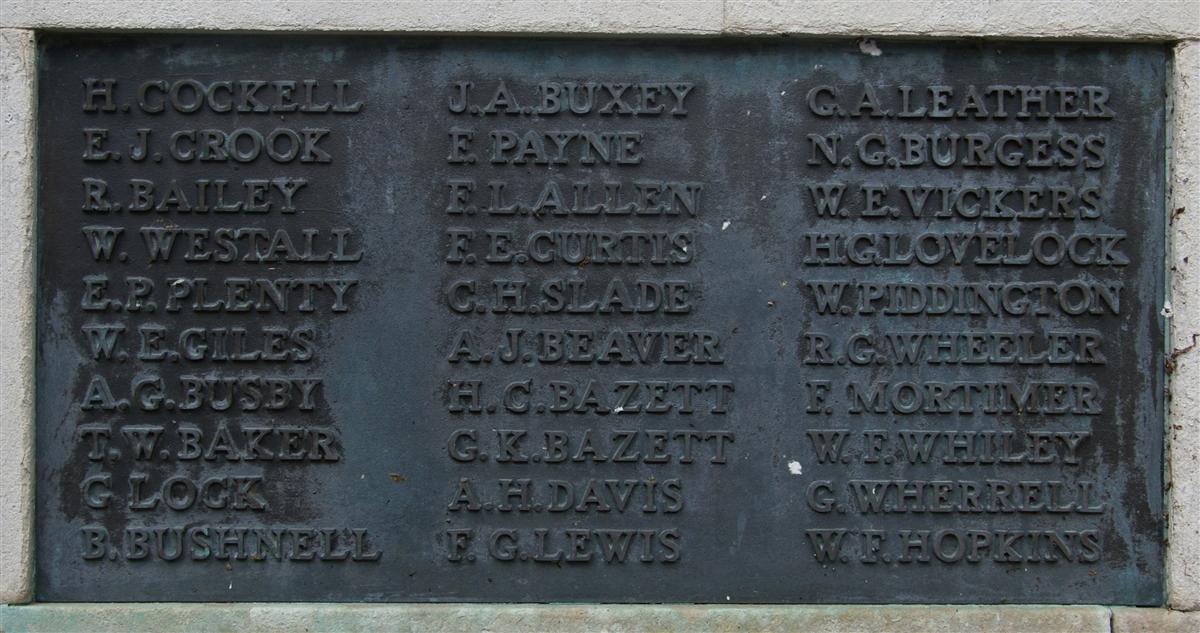
Edward's name on Newbury War Memorial (centre left) |
He is remembered on Tablet 9 of the Newbury Town War Memorial, on the memorial to the fallen old boys of Newbury Grammar School (now housed in the reception area of St Bartholomew’s School) and, of course, on his grave in Newtown Road Cemetery. He was also remembered on the memorial to the fallen parishioners of St John’s Church, Newbury, which was lost to an enemy bomb in 1943.

Find a memorial :
| Died this day: | |
| 15 January 1943 | |
| L C Lawrence | |
| Newbury |

Like this site? Show your appreciation through a donation to a great charity.
